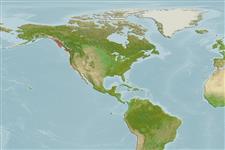Teleostei (teleosts) >
Perciformes/Cottoidei (Sculpins) >
Cottidae (Sculpins)
Etymology: Synchirus: Greek, syn, symphysis = grown together + Greek, cheir = hand (Ref. 45335); gilli: Named after Theodore Gill, U.S. ichthyologist (Ref. 6885).
Eponymy: Professor Theodore Nicholas Gill (1837–1914) was an American ichthyologist, malacologist, mammologist and librarian, a zoologist at George Washington University and associated with the Smithsonian Institution for more than half a century. [...] (Ref. 128868), visit book page.
More on author: Bean.
Environment: milieu / climate zone / depth range / distribution range
Ecology
Marine; demersal. Temperate; 59°N - 32°N
Eastern Pacific: Sitka, Alaska to San Miguel Island, southern California, USA.
Length at first maturity / Size / Weight / Age
Maturity: Lm ?, range 5 - ? cm
Max length : 7.0 cm TL male/unsexed; (Ref. 2850)
Short description
Identification keys | Morphology | Morphometrics
Found in bays, tide pools and among kelp (Ref. 2850). Previously thought as rare species, but relatively common in some areas, especially kelp beds (Ref. 2850). Feeds on small crustaceans (Ref. 6885). Can cling to bottoms or pilings with its pectoral and pelvic fins (Ref. 2850).
Life cycle and mating behavior
Maturity | Reproduction | Spawning | Eggs | Fecundity | Larvae
Eschmeyer, W.N., E.S. Herald and H. Hammann, 1983. A field guide to Pacific coast fishes of North America. Boston (MA, USA): Houghton Mifflin Company. xii+336 p. (Ref. 2850)
IUCN Red List Status (Ref. 130435: Version 2024-1)
Threat to humans
Harmless
Human uses
Tools
Special reports
Download XML
Internet sources
Estimates based on models
Preferred temperature (Ref.
123201): 6.4 - 12.8, mean 9.3 °C (based on 242 cells).
Phylogenetic diversity index (Ref.
82804): PD
50 = 1.0000 [Uniqueness, from 0.5 = low to 2.0 = high].
Bayesian length-weight: a=0.00589 (0.00281 - 0.01234), b=3.15 (2.97 - 3.33), in cm total length, based on LWR estimates for this (Sub)family-body shape (Ref.
93245).
Trophic level (Ref.
69278): 3.5 ±0.50 se; based on food items.
Resilience (Ref.
120179): High, minimum population doubling time less than 15 months (Preliminary K or Fecundity.).
Fishing Vulnerability (Ref.
59153): Low vulnerability (10 of 100).
Nutrients (Ref.
124155): Calcium = 154 [59, 376] mg/100g; Iron = 0.488 [0.222, 1.170] mg/100g; Protein = 17.1 [14.9, 19.3] %; Omega3 = 0.838 [0.328, 2.461] g/100g; Selenium = 12.3 [5.0, 33.6] μg/100g; VitaminA = 38.6 [9.2, 144.8] μg/100g; Zinc = 0.969 [0.601, 1.751] mg/100g (wet weight);
